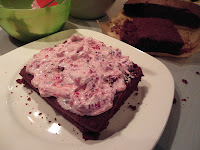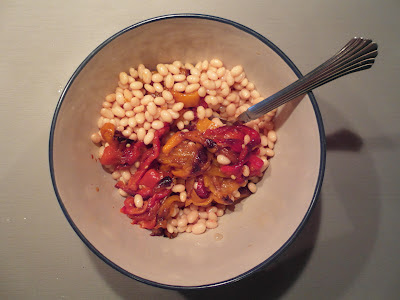It was my birthday on Sunday. As we were travelling, I didn't have time to make a cake, and hadn't even thought about making one, until a friend mentioned it. So, here is my birthday cake. One day late, oh well!
The cake for this recipe came from my Mum; thanks Mum. But you could easily use a packet mix for this. Most of the work is with the building and decoration of the cake.
The inspiration for the decoration came from this 'celebration cake' I found online.
The rest came from me. The combination of the lovely chocolate cake, sweet ganache, tart and creamy raspberry filling, and the yummy chocolaty bits on top was fabulous. The little people were very excited helping to make and eat this cake. I was impressed with how it turned out; very beautiful and worth the effort. Happy birthday to me!
My cake was a square shape, but you could also make it using round cakes. If you choose round, then you will need to make two cakes in two separate 20cm round tins.
What you'll need
*This is a rich cake, so you will only need a small piece to satisfy. The square cake I made would serve 6 or 8 people. If you made this with round cakes, you could serve 10 to 12 people.
For the cake
125g butter, softened
220g firmly packed brown sugar
110g caster sugar
3 eggs
300g plain flour
40g cocoa powder
1 tsp bicarb soda
170g sour cream
120ml water
For the filling
200g fresh raspberries
200g Philadelphia cream cheese
For the ganache
250g dark cooking chocolate
1/3 cup heavy cream
For the decoration
10 'Malteaser' balls
6 'Lindt' chocolate balls
6 'Rafello' balls
What to do
For the cake - preheat the oven to 180 degrees Celsius. Grease and line a rectangular cake tin, approx 40cm x 30cm.
Place all ingredients in a bowl. Mix for approximately four minutes with an electric mixer on medium speed, until well combined.
Pour into pre-prepared cake tin and place in the oven. Bake for approximately 35 minutes, check it is cooked in the middle using a skewer. Rest in the pan for 15 minutes, before turning out onto a wire rack.
The cake must be fully cooled before you start to cut or decorate it.
Meanwhile, make the ganache. Break the chocolate into small pieces and place in a ceramic bowl. Heat the cream in a saucepan, but do not boil it. Once hot, pour the cream over the chocolate, and mix with a metal spoon until the chocolate is melted and the mixture is smooth. If the chocolate doesn't melt fully, place in the microwave for 15 seconds and stir further until all melted. Set aside to cool.
Make the filling. Place the raspberries and the cream cheese into a bowl and mash/mix together. You will have a lumpy filling, but this is perfect.
Assemble the cake
- Cut the cake into four even square pieces (you will only use three pieces for this recipe). If the top of the cake is not even, use a serrated knife to cut the top and flatten it out.
- Place one piece of cake on a large plate or tray. Spoon half of the raspberry mixture onto the cake and smooth it to the edges.
- Place the next piece of cake on top, squishing down slightly. Put the other half of the raspberry mixture on top of this. Top with the third piece of cake.
- Check that the sides of the cake are even and flat. If there are parts sticking out, you can use a serrated knife to cut small parts off to even it out.
- Use a palate knife or spoon to smooth on the cooled ganache. Start at the top of the cake and work down the sides. I did this in two parts. Once I had a mostly even coverage over the whole cake, I put it in the fridge for half an hour to help everything set. I then did a finishing top coat with the left-over ganache.
- Remove the cake from the plate/tray (I used an egg flip for this) and put it onto a clean serving plate.
- Decorate with the chocolate balls and serve.
- Enjoy.





















































